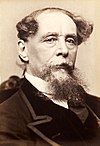
Charles John Huffam Dickens was an English novelist and social critic who created some of the world's best-known fictional characters, and is regarded by many as the greatest novelist of the Victorian era. His works enjoyed unprecedented popularity during his lifetime and, by the 20th century, critics and scholars had recognised him as a literary genius. His novels and short stories are widely read today.
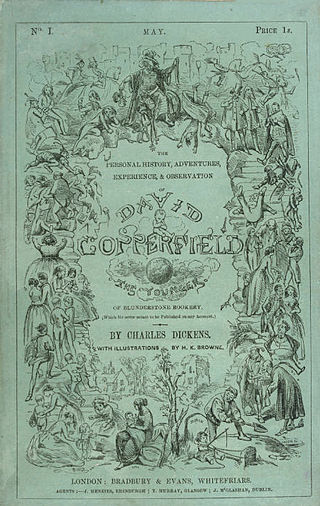
David Copperfield is a novel by Charles Dickens, narrated by the eponymous David Copperfield, detailing his adventures in his journey from infancy to maturity. As such, it is typically categorized in the bildungsroman genre. It was published as a serial in 1849 and 1850 and then as a book in 1850.
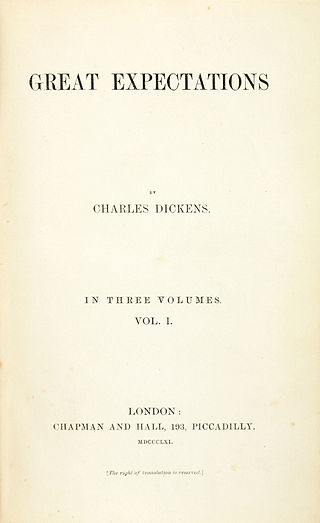
Great Expectations is the thirteenth novel by Charles Dickens and his penultimate completed novel. It depicts the education of an orphan nicknamed Pip. It is Dickens' second novel, after David Copperfield, to be fully narrated in the first person. The novel was first published as a serial in Dickens's weekly periodical All the Year Round, from 1 December 1860 to August 1861. In October 1861, Chapman & Hall published the novel in three volumes.
This article contains information about the literary events and publications of 1842.

Samuel Gridley Howe was an American physician, abolitionist, and advocate of education for the blind. He organized and was the first director of the Perkins Institution. In 1824 he had gone to Greece to serve in the revolution as a surgeon; he also commanded troops. He arranged for support for refugees and brought many Greek children back to Boston with him for their education.
Perkins School for the Blind, in Watertown, Massachusetts, was founded in 1829 and is the oldest school for the blind in the United States. It has also been known as the Perkins Institution for the Blind.

Sir Thomas Wemyss Reid was an English newspaper editor, novelist and biographer.

The Cricket on the Hearth: A Fairy Tale of Home is a novella by Charles Dickens, published by Bradbury and Evans, and released 20 December 1845 with illustrations by Daniel Maclise, John Leech, Richard Doyle, Clarkson Stanfield and Edwin Henry Landseer. Dickens began writing the book around 17 October 1845 and finished it by 1 December. Like all of Dickens's Christmas books, it was published in book form, not as a serial.

Hablot Knight Browne was a British artist and illustrator. Well known by his pen name, Phiz, he illustrated books by Charles Dickens, Charles Lever, and Harrison Ainsworth.

Laura Dewey Lynn Bridgman was the first deaf-blind American child to gain a significant education in the English language, twenty years before the more famous Helen Keller; Laura's friend Anne Sullivan became Helen Keller's aide. Bridgman was left deaf-blind at the age of two after contracting scarlet fever. She was educated at the Perkins Institution for the Blind where, under the direction of Samuel Gridley Howe, she learned to read and communicate using Braille and the manual alphabet developed by Charles-Michel de l'Épée.

Julia Brace was a deafblind woman who enrolled at the American School for the Deaf, in Hartford, Connecticut, in 1825 and remained there as an employee after her graduation.
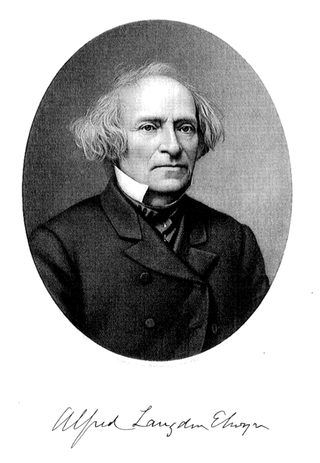
Alfred Langdon Elwyn was an American physician, author and philanthropist. He was a pioneer in the education and care of people with mental and physical disabilities. He was one of the founding officers of the Pennsylvania Institution for the Instruction of the Blind in 1833 and founded the Pennsylvania Training School for Feeble-Minded Children in 1852. The community of Elwyn, Pennsylvania and the Elwyn Institute are named in his honor.

Dickens in America is a 2005 television documentary following Charles Dickens's travels across the United States in 1842, during which the young journalist penned a travel book, American Notes. It is hosted by British actress Miriam Margolyes, a lifelong fan of Dickens, and intersperses history with travelogue and interviews. It was produced by Lion Television Scotland for BBC Four. Nathaniel Parker provided the voice of Dickens, quoting from his texts throughout the journey.

Michael Francis Phelan was a U.S. Representative from Massachusetts.
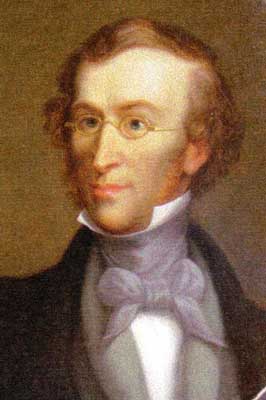
John Dix Fisher was a physician and founder of Perkins Institution for the Blind in Boston, Massachusetts. He is credited with introducing the stethoscope into the United States and was an early advocate for the practice of mediate auscultation. He discovered what was called "cephalic bellows-sound" or "cerebral murmur", a phenomenon related to cerebral circulation which was thought to be a physical symptom of diseases of the brain. He was a founding member of the American Statistical Association.

Georgina Hogarth was the sister-in-law, housekeeper, and adviser of English novelist Charles Dickens and the editor of three volumes of his collected letters after his death.
Dora Annie Dickens was the infant daughter of English novelist Charles Dickens and his wife Catherine. She was the ninth of their ten children, and the youngest of their three daughters.

Elizabeth Culliford Dickens was the wife of John Dickens and the mother of British novelist Charles Dickens. She was the source for Mrs. Nickleby in her son's novel Nicholas Nickleby and for Mrs Micawber in David Copperfield.

Thomas Stringer was an American carpenter. Deafblind from a young age, Stringer was brought to the Perkins Institution for the Blind through the fundraising of Helen Keller. He was well-regarded at the school for his carpentry skills, which he used to help support himself after graduating from Perkins in 1913.
Mary Swift Lamson, was an American educator and writer best known as a teacher of Laura Bridgman, at the Perkins Institute for the Blind. She wrote the book Life and Education of Laura Dewey Bridgman, the Deaf, Dumb, and Blind Girl (1884) about her experiences teaching Bridgman.

















